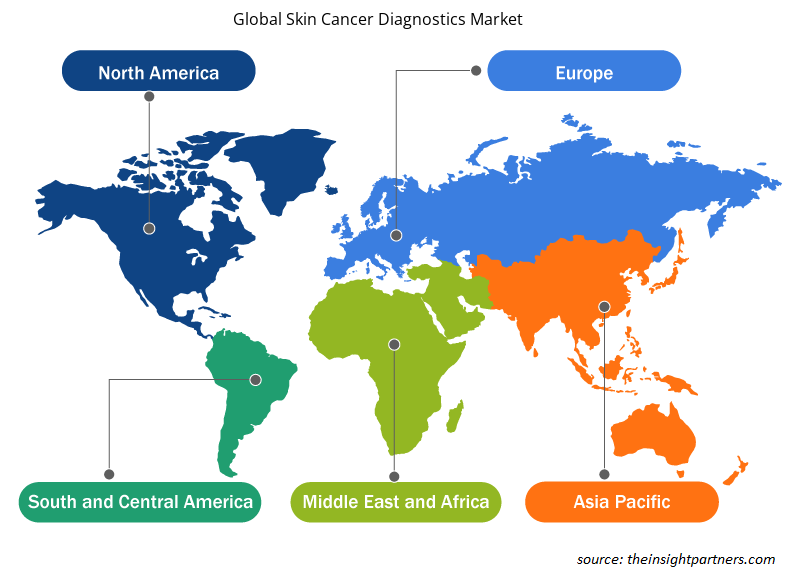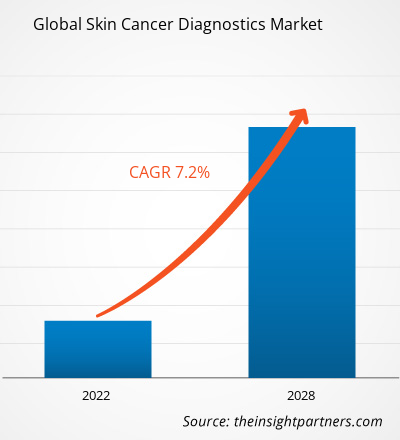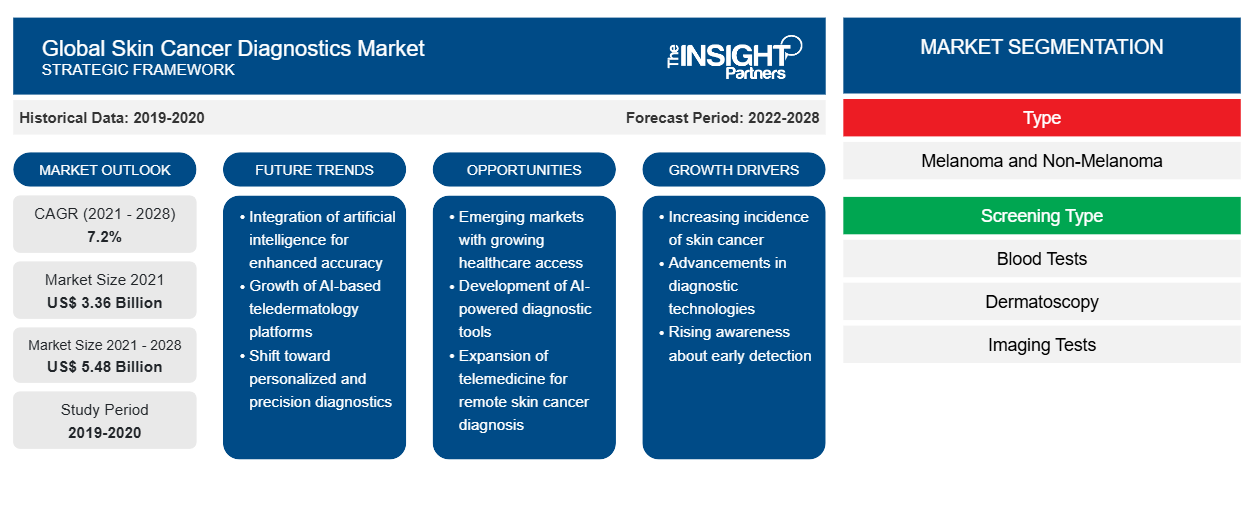2021 年全球皮肤癌诊断市场价值为 33.6446 亿美元,预计到 2028 年将达到 54.8045 亿美元,2021-2028 年期间的复合年增长率为 7.2%。
皮肤癌发病率的上升和新产品的推出是推动市场增长的主要因素,而中低收入国家早期皮肤癌诊断的障碍限制了全球皮肤癌诊断市场的扩张
皮肤癌是由于皮肤细胞异常生长而引起的,通常发生在暴露在阳光下的区域。紫外线 (UV) 辐射是皮肤癌的主要原因,它会改变细胞的遗传组成 (DNA)。黑色素瘤和非黑色素瘤是皮肤癌的两大类别。CT 扫描、MRI、PET 扫描、骨扫描和胸部 X 光等多种成像解决方案可用于诊断该疾病。此外,诊断疗法包括化疗、靶向治疗、免疫治疗、放射治疗、冷冻治疗和刮痧疗法,以帮助治愈皮肤病。
从地区来看,北美占据了全球皮肤癌诊断市场的大部分份额,并可能在整个预测期内保持主导地位。亚太地区是利润最丰厚的市场,由于临床试验数量不断增加以及开发新皮肤疗法的投资不断增加,预计该地区将以最快的速度发展。著名的皮肤癌诊断市场参与者一直致力于有机和无机发展。前者包括产品发布和批准,而后者包括合作、收购和伙伴关系。具体来说,有机发展占战略增长的 74%,而无机发展贡献占业务扩张的 26%。这种增长战略帮助公司提升了市场价值并确立了地位。
定制此报告以满足您的需求
您可以免费定制任何报告,包括本报告的部分内容、国家级分析、Excel 数据包,以及为初创企业和大学提供优惠和折扣
-
获取此报告的关键市场趋势。这个免费样品将包括数据分析,从市场趋势到估计和预测。
COVID-19的影响
非紧急皮肤手术的延迟和中断导致全球皮肤癌诊断市场停滞
全球 COVID-19 疫情扰乱了皮肤癌诊断市场,导致业务运营暂停。在北美,非紧急医疗服务中断。2020 年至 2021 年中期该地区的封锁导致临床就诊延迟。黑色素瘤和其他皮肤癌的诊断时间比平时更长。医院的皮肤活检数量急剧减少。皮肤活检数量下降了 15%,疫情期间仍有大量积压病例未清理。诊断后的治疗和管理被推迟,导致某些皮肤癌死亡病例。2020 年,仅黑色素瘤就占美国所有癌症病例的 5.6%,造成最多死亡人数。总体而言,疫情对美国皮肤癌服务的常规管理产生了深远影响。
在欧洲,包括皮肤癌切除术在内的常规手术被推迟。医疗保健常规发生了根本性变化,对外科手术产生了严重影响。致癌治疗因漏诊和误诊而受到阻碍,治疗陷入停滞。推迟就诊导致复杂的健康影响。尽管疫情过后皮肤活检恢复,但仍有大量未干预病例持续了近半年。优先考虑 COVID 感染患者并停止其他医疗服务使亚太地区的医疗保健行业处于关键地位。医疗资源得到合理化,以管理 COVID-19 病例的涌入。这给癌症患者的常规护理系统造成了严重破坏。及时获得医疗保健的延误和中断使情况恶化,迫使患者选择昂贵的晚期致癌治疗。整个地区的常规癌症筛查实践被停止。该地区的医疗系统开始认识到癌症的变化无常和致命性,以及它与其他普遍的健康问题之间的交集。
未来趋势
人工智能辅助皮肤癌诊断
先进的皮肤镜有助于更好地可视化皮肤癌,诊断灵敏度提高 10-30%。同样,人工智能 (AI) 技术的应用也扩展到早期皮肤癌检测。2022 年 2 月,弗劳恩霍夫辅助信息和通信解决方案中心 (AICOS) 的研究人员推出了 Derm.AI 软件,可对看起来可能有害的皮肤病变进行初步评估。该软件可能会帮助皮肤科医生分析皮肤癌的病例和风险。2017 年 1 月,斯坦福大学的一组研究人员开发了一种用于皮肤癌诊断的 AI 算法。他们创建了一个包含超过 130,000 张皮肤病图像的数据库,他们的算法从第一次测试开始就可视化了潜在的癌症。Veriskin Inc. 推出了 TruScore,这是一款由 AI 支持的非侵入性、低成本、手持式设备,用于皮肤癌诊断和筛查。
驱动程序
皮肤癌发病率不断上升
根据世界卫生组织的数据,2020 年报告的皮肤癌病例超过 120 万例。皮肤癌是迄今为止所有癌症类型中最常见的一种。尽管黑色素瘤占皮肤癌总病例的 1% 左右,但它造成的死亡人数最多。过去几十年来,黑色素瘤的发病率迅速上升,且随年龄而变化。紫外线照射增加会导致基因突变,从而导致皮肤癌病情延长。根据美国癌症协会 2022 年的统计数据,约有 7,650 人可能死于黑色素瘤,其中约 5080 名男性和 2570 名女性。根据 GLOBOCAN 2020,全球登记的癌症病例超过 1930 万例,不包括 1810 万例非黑色素瘤皮肤癌病例。一些国家已经实施了全国性的癌症意识和早期诊断计划,从而推动了全球皮肤癌诊断市场的增长。
推出新的皮肤癌诊断产品
及早发现和及时诊断皮肤癌可为癌症患者带来生命。为此,各公司都强调提供先进的产品以更快地诊断皮肤癌。3Derm Systems, Inc. 开发了 3DermSpot,这是一种基于 AI 的算法,可使用标准皮肤图像自主检测黑色素瘤、鳞状细胞癌和基底细胞癌。DermaSensor Inc. 推出了 DermaSensor 设备作为评估提示皮肤癌的病变的客观工具。该设备提供肉眼看不见的细胞亚结构的反馈,即使通过皮肤镜检查也是如此。2021 年 5 月,SciBase Holding AB 推出了其非黑色素瘤皮肤癌 (NMSC) 临床应用和 MDR 认证流程。主要市场参与者的此类创新必将加速全球皮肤癌诊断市场的增长。
限制
中低收入国家早期皮肤癌诊断市场的障碍
健康知识缺乏、对癌症的偏见、初级保健机会有限、临床评估不准确、临床诊断延迟、无法进行检测以及缺乏人员随访是阻碍中低收入经济体癌症早期诊断的合法因素。不当的医疗保健管理通常会在癌症晚期或中期才诊断出来,最终导致死亡率上升。缺乏认识导致中等经济国家儿童癌症发病率和死亡率激增。然而,那里的医疗保健提供者缺乏升级医疗基础设施和服务质量所必需的资源。高昂的诊断和成像设备成本、低报销率和预算限制限制了癌症诊断,导致诊断结果不明确且不敏感。低收入地区的这些挑战制约了全球皮肤癌诊断市场的增长。
市场细分
按类型
非黑色素瘤皮肤癌发病率上升,导致节段性增长激增
全球皮肤癌诊断市场按类型分为黑色素瘤和非黑色素瘤。后者在 2021 年占据了市场主导地位,收入份额最大,预计在预测期内将以最高的复合年增长率增长。细分市场的增长是由于基底细胞癌和鳞状细胞癌病例的增加以及对非黑色素瘤皮肤癌的宣传活动所导致的。尽管非黑色素瘤癌症可以通过手术治愈,而且很少致命,但手术治疗既痛苦又会毁容。由于登记不可靠,发病率很难确定。位于纬度下降地区、紫外线辐射水平较高的国家报告的非黑色素瘤癌症病例更多。皮肤癌基金会表示,全球每月有超过 5,400 名患者死于非黑色素瘤癌症。
2021 年,黑色素瘤领域是全球皮肤癌诊断市场的第二大市场。根据世界卫生组织 2017 年 10 月发布的数据,全球每年登记的黑色素瘤皮肤癌病例约为 132,000 例。在美国,病例平均增长了 4%。根据 GLOBOCAN 2020,2020 年新发黑色素瘤病例数接近 324,635 例。尽管恶性黑色素瘤皮肤癌的发病率低于非黑色素瘤皮肤癌,但它仍然是导致死亡的主要原因。
按筛选类型
活检程序的众多优势巩固了该领域的主导地位
根据筛查类型,全球皮肤癌诊断市场细分为皮肤活检、血液检查、皮肤镜检查、影像学检查和淋巴结活检。皮肤活检部分在 2021 年占据了最大的市场份额,并且很可能在预测期内实现最高的复合年增长率。皮肤活检程序需要切开并去除一小部分皮肤进行测试。它可以检测皮肤癌、感染或其他皮肤状况。皮肤样本通过不同类型的活检收集和评估,例如穿刺活检、切除活检、切开活检和刮除活检。特别是,在非黑色素瘤的情况下,活检通常是诊断癌症分期或扩散的唯一测试。
皮肤镜检查部分紧随皮肤活检之后,涵盖 2021 年的全球皮肤癌诊断市场。它是增长最快的部分之一。它提高了检测皮肤癌的敏感性,减少了活检的良性病变数量,并能够诊断出较薄的黑色素瘤。由于这些好处,皮肤镜检查被广泛用作皮肤癌的主要筛查测试。这是一种具有成本效益的程序,可减少切除的良性病变数量。皮肤镜重量轻、电池供电,并且配有方便的附件,可通过智能手机进行记录。
区域洞察
从地理上看,全球皮肤癌诊断市场分为北美、欧洲、亚太地区 (APAC)、南美和中美 (SCAM) 以及中东和非洲 (MEA)。
北美在 2021 年占据了最大的市场份额,预计到 2028 年仍将保持主导地位。该地区最高的市场占有率归因于皮肤癌发病率的增加、认识的提高和产品发布的增加。美国市场因皮肤癌发病率、政府支持的增加以及皮肤癌诊断市场检测产品的先进而蓬勃发展。研究表明,BCC 和 SCC 等非黑色素瘤皮肤癌每年影响超过 300 万美国公民。皮肤癌基金会透露,至少五分之一的美国人会在 70 岁之前患上皮肤癌。在加拿大,黑色素瘤非常普遍,对癌症患者来说同样致命。皮肤癌发病率在全国范围内变得很常见。根据加拿大皮肤癌基金会的数据,每年登记的皮肤癌病例超过 80,000 例,其中约 5,000 例报告黑色素瘤皮肤癌。全国皮肤癌病例数超过乳腺癌、前列腺癌、肺癌和结肠癌病例数的总和。
预计亚太地区皮肤癌诊断市场将在预测期内以最高的复合年增长率扩张。区域市场的增长归因于老年人口的快速增长、医疗保健基础设施的改善、人均收入的增长以及主要参与者的发展。此外,临床试验数量的增加、公共和私人对治疗开发的投资、研发活动支出的增加、先进的临床技术和创新的医疗诊断设备都是推动区域皮肤癌诊断市场在预测期内增长的主要因素。在中国,皮肤癌一直是一个重大的公共卫生问题。中国人口快速老龄化继续给医疗保健系统带来财政压力。在印度,接触紫外线 B 辐射和饮用水中砷含量较高与皮肤癌有关。根据印度医学研究理事会 (ICMR) 的数据,印度北部的黑色素瘤发病率最高。
皮肤癌诊断
全球皮肤癌诊断市场区域洞察
Insight Partners 的分析师已详尽解释了预测期内影响全球皮肤癌诊断市场的区域趋势和因素。本节还讨论了全球皮肤癌诊断市场在北美、欧洲、亚太地区、中东和非洲以及南美和中美洲的细分市场和地理位置。

- 获取全球皮肤癌诊断市场的区域特定数据
全球皮肤癌诊断市场报告范围
| 报告属性 | 细节 |
|---|---|
| 2021 年市场规模 | 33.6亿美元 |
| 2028 年市场规模 | 54.8亿美元 |
| 全球复合年增长率(2021 - 2028) | 7.2% |
| 史料 | 2019-2020 |
| 预测期 | 2022-2028 |
| 涵盖的领域 |
按类型
|
| 覆盖地区和国家 |
北美
|
| 市场领导者和主要公司简介 |
|
全球皮肤癌诊断市场参与者密度:了解其对业务动态的影响
全球皮肤癌诊断市场正在快速增长,这得益于终端用户需求的不断增长,而这些需求又源于消费者偏好的不断变化、技术进步以及对产品优势的认识不断提高等因素。随着需求的增加,企业正在扩大其产品范围,进行创新以满足消费者的需求,并利用新兴趋势,从而进一步推动市场增长。
市场参与者密度是指在特定市场或行业内运营的企业或公司的分布情况。它表明在给定市场空间中,相对于其规模或总市场价值,有多少竞争对手(市场参与者)存在。
在全球皮肤癌诊断市场运营的主要公司有:
- SkylineDx BV
- AMLo 生物科学有限公司
- 尼拉凯尔有限公司
- DermLite 有限责任公司
- 生物梅里埃公司
免责声明:上面列出的公司没有按照任何特定顺序排列。

- 了解全球皮肤癌诊断市场主要参与者概况
主要市场参与者:
- SkylineDx BV(荷兰)
- AMLo Biosciences Limited(英国)
- NeraCare GmbH (德国)
- DermLite LLC(美国)
- 生物梅里埃公司(法国)
- Veriskin Inc(美国)
- Castle Biosciences, Inc.(美国)
- DermTech Inc(美国)
- 霍夫曼-拉罗氏有限公司(瑞士)
- Michelson Diagnostics Ltd(英国)
主要进展:
-
2021 年 12 月:
SkyineDx 与生命科学研究所 VIB 建立了为期 3 年的战略合作伙伴关系,以评估和启动以分子诊断为重点的合作项目。 -
2020 年 7 月:
Veriskin 凭借其 TruScore 设备获得了美国 FDA 突破性设备称号。 -
2021 年 4 月:
Castle Biosciences, Inc. 签署最终协议,以 3250 万美元从 Myriad Genetics 收购 Myriad myPath, LLC (Myriad myPath Laboratory) 的全部股权。
报告范围
全球皮肤癌诊断市场研究报告提供了有关市场规模、份额、趋势和预测的详细见解。它提供了有关驱动因素、限制因素、机会、细分市场和行业格局的清晰而准确的知识。讨论了 COVID-19 影响分析以及全球和区域市场随之而来的后果。一份关键市场参与者名单及其近年来各自的发展情况被特别提及。
- 历史分析(2 年)、基准年、预测(7 年)及复合年增长率
- PEST和SWOT分析
- 市场规模、价值/数量 - 全球、区域、国家
- 行业和竞争格局
- Excel 数据集
近期报告
客户评价
购买理由
- 明智的决策
- 了解市场动态
- 竞争分析
- 客户洞察
- 市场预测
- 风险规避
- 战略规划
- 投资论证
- 识别新兴市场
- 优化营销策略
- 提升运营效率
- 顺应监管趋势























 获取免费样品 - 全球皮肤癌诊断市场
获取免费样品 - 全球皮肤癌诊断市场